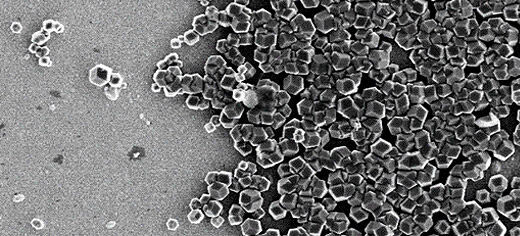
Forget computer viruses - magnet-making bacteria could be used to build tomorrow's computers with larger hard drives and speedier connections.
Researchers at the University of Leeds have used a type of bacterium which 'eats' iron to create a surface of magnets, similar to those found in traditional hard drives, and wiring. As the bacterium ingests the iron it creates tiny magnets within itself.
The team has also begun to understand how the proteins inside these bacteria collect, shape and position these "nanomagnets" inside their cells and can now replicate this behaviour outside the bacteria.
Led by Dr Sarah Staniland from the University's School of Physics and Astronomy, in a longstanding collaboration with the Tokyo University of Agriculture and Technology, the team hope to develop a 'bottom-up' approach for creating cheaper, more environmentally-friendly electronics of the future.
Dr Staniland said: "We are quickly reaching the limits of traditional electronic manufacturing as computer components get smaller. The machines we've traditionally used to build them are clumsy at such small scales. Nature has provided us with the perfect tool to circumvent this problem."
The magnetic array was created by Leeds PhD student Johanna Galloway using a protein which creates perfect nanocrystals of magnetite inside the bacterium Magnetospirilllum magneticum. In a process akin to potato-printing on a much smaller scale, this protein is attached to a gold surface in a checkerboard pattern and placed in a solution containing iron.
At a temperature of 80°C, similarly-sized crystals of magnetite form on the sections of the surface covered by the protein. The team are now working to reduce the size of these islands of magnets, in order to make arrays of single nanomagnets. They also plan to vary the magnetic materials that this protein can control. These next steps would allow each of these nanomagnets to hold one bit of information allowing the construction of better hard drives.
"Using today's 'top-down' method - essentially sculpting tiny magnets out of a big magnet - it is increasingly difficult to produce the small magnets of the same size and shape which are needed to store data," said Johanna Galloway. "Using the method developed here at Leeds, the proteins do all the hard work; they gather the iron, create the most magnetic compound, and arrange it into regularly-sized cubes."
A different protein has been used to create tiny electrical wires by Dr Masayoshi Tanaka, during a secondment to Leeds from Tokyo University of Agriculture and Technology. These 'nanowires' are made of 'quantum dots' - particles of copper indium sulphide and zinc sulphide which glow and conduct electricity - and are encased by fat molecules, or lipids.
The magnetic bacteria contain a protein that moulds mini compartments for the nanomagnets to be formed in using the cell membrane lipids. Dr Tanaka used a similar protein to make tubes of fat containing quantum dots - biological-based wiring.
"It is possible to tune these biological wires to have a particular electrical resistance. In the future, they could be grown connected to other components as part of an entirely biological computer," said Dr Tanaka.
The research group and the team at Tokyo University of Agriculture and Technology, led by Prof. Tadashi Matsunaga, now plan to examine the biological processes behind the behaviour of these proteins. "Our aim is to develop a toolkit of proteins and chemicals which could be used to grow computer components from scratch," adds Dr Staniland.
The papers Biotemplated Magnetic Nanoparticle Arrays and Fabrication of Lipid Tubules with Embedded Quantum Dots by Membrane Tubulation Protein are published in the journal Small.
This research is funded by the Engineering and Physical Sciences Research Council (EPSRC), Biotechnology and Biological Sciences Research Council (BBSRC) and the Royal Society's Newton International Fellowships Scheme.
Further information
Dr Sarah Staniland is available for interview. Accompanying pictures can be downloaded here:
https://docs.google.com/open?id=0B691WmQZab8LZkptRTViSFE2UXc
https://docs.google.com/open?id=0B691WmQZab8LUE4xOTl5cF9OX1E
Contact: University of Leeds Communications & Press Office: Tel +44 (0)113 343 4031, email pressoffice@leeds.ac.uk
Notes to Editor
- Galloway, J. M., Bramble, J. P., Rawlings, A. E., Burnell, G., Evans, S. D. and Staniland, S. S. (2012), Biotemplated Magnetic Nanoparticle Arrays. Small, 8: 204-208. (http://onlinelibrary.wiley.com/doi/10.1002/smll.201101627/abstract)
- Tanaka, M., Critchley, K., Matsunaga, T., Evans, S. D. and Staniland, S. S. (2012), Fabrication of Lipid Tubules with Embedded Quantum Dots by Membrane Tubulation Protein. Small. (http://onlinelibrary.wiley.com/doi/10.1002/smll.201102446/abstract)
- A copy of the papers is available to journalists on request.
- The Engineering and Physical Sciences Research Council (EPSRC) is the UK's main agency for funding research in engineering and physical sciences. EPSRC invests around £800m a year in research and postgraduate training, to help the nation handle the next generation of technological change. The areas covered range from information technology to structural engineering, and mathematics to materials science. This research forms the basis for future economic development in the UK and improvements for everyone's health, lifestyle and culture. EPSRC works alongside other Research Councils with responsibility for other areas of research. The Research Councils work collectively on issues of common concern via research Councils UK. http://www.epsrc.ac.uk/
- BBSRC invests in world-class bioscience research and training on behalf of the UK public. Our aim is to further scientific knowledge, to promote economic growth, wealth and job creation and to improve quality of life in the UK and beyond. Funded by Government, and with an annual budget of around £445M, we support research and training in universities and strategically funded institutes. BBSRC research and the people we fund are helping society to meet major challenges, including food security, green energy and healthier, longer lives. Our investments underpin important UK economic sectors, such as farming, food, industrial biotechnology and pharmaceuticals. http://www.bbsrc.ac.uk/